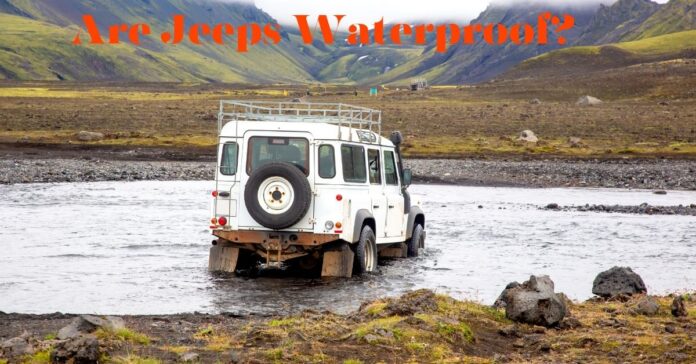When it comes to off-roading and exploring rugged terrains, Jeeps have gained a reputation for their remarkable capabilities. One question that often arises among Jeep enthusiasts is, “Are Jeeps waterproof?” In this comprehensive guide, we will delve into the topic and explore the water resistance of Jeeps, shedding light on their design features, maintenance tips, and the limitations to keep in mind while fording water obstacles.
Understanding Jeep’s Water Resistance Design
Jeep’s Waterproof Features:
Jeep vehicles are not inherently designed to be completely waterproof, but they do possess certain features that enhance their water resistance capabilities. Here are some key design elements that contribute to the Jeep’s ability to handle water-related challenges:
High Ground Clearance: Jeeps typically boast higher ground clearance compared to standard vehicles. This design feature helps prevent water from entering the cabin, as the elevated chassis keeps crucial components and electrical systems above water levels.
Elevated Air Intake: Another crucial design consideration is the elevated air intake. Jeeps often have their air intakes positioned higher to avoid water entering the engine during water crossings. This prevents hydrolock, a condition where water enters the cylinders and causes severe engine damage.
Sealed Electrical Systems: Jeeps are equipped with sealed electrical systems that minimize the risk of short circuits and electrical failures when encountering water. These specially designed electrical components reduce the chances of damage due to moisture exposure.
Maintaining Water Resistance
Proper Maintenance Tips
While Jeeps possess impressive water-resistant features, it is crucial to understand that no vehicle is completely waterproof. To ensure your Jeep maintains its water resistance over time, follow these essential maintenance tips:
Regular Inspection: Inspect your Jeep thoroughly for any signs of wear and tear, paying particular attention to door seals, window seals, and other potential entry points for water. Replace or repair any damaged seals promptly.
Check Ventilation Systems: Keep the ventilation systems, such as the heating, ventilation, and air conditioning (HVAC) system, in good working condition. Proper ventilation prevents moisture buildup inside the vehicle, reducing the chances of interior damage.
Fluid Checks: Regularly inspect and maintain all fluid levels, including engine oil, transmission fluid, and differential fluid. These checks help ensure the optimal performance of various components during water crossings.
Limitations and Precautions
Understanding the Limitations
Despite their impressive water resistance capabilities, Jeeps have certain limitations when it comes to water crossings. It is important to be aware of these limitations and take necessary precautions:
Depth of Water: Jeeps have varying water fording capabilities depending on the model and specifications. It is crucial to consult your vehicle’s owner’s manual to determine the maximum recommended water depth for safe crossings.
Current and Flowing Water: Jeeps are designed to handle water crossings but are not meant for navigating strong currents or fast-flowing water. Attempting to drive through such conditions can be dangerous and result in loss of control.
Aftermarket Modifications: Be cautious with aftermarket modifications, as they can impact a Jeep’s water resistance capabilities. Adding larger tires, lifting kits, or altering the vehicle’s design may affect the vehicle’s ability to handle water crossings. Consult with experts before making any modifications.
Conclusion
While Jeeps possess water-resistant features that make them suitable for water crossings, it is important to recognize their limitations. Understanding the design features and following proper maintenance guidelines will help ensure your Jeep performs optimally during water-related challenges. Always prioritize safety and refer to the vehicle’s manual for specific recommendations regarding water depth and conditions. By doing so, you can fully enjoy the capabilities of your Jeep while also protecting its longevity and reliability.
In conclusion, Jeeps are not completely waterproof but have several design features that enhance their water resistance. Their high ground clearance, elevated air intakes, and sealed electrical systems contribute to their ability to handle water-related challenges. However, it is important to practice proper maintenance, inspect for wear and tear, and be aware of the limitations and precautions associated with water crossings. By following these guidelines, you can confidently navigate water obstacles with your Jeep and ensure its optimal performance in various off-road adventures.
FAQS
Q1: Can I drive my Jeep through deep water?
Answer: Jeeps are designed to handle water crossings, but the maximum recommended water depth varies depending on the model. Consult your Jeep’s owner’s manual to determine the safe water depth for your specific vehicle.
Q2: Are Jeeps completely waterproof?
Answer: Jeeps are not completely waterproof, but they possess water-resistant features. Their design elements, such as high ground clearance, elevated air intake, and sealed electrical systems, enhance their ability to handle water challenges.
Q3: What precautions should I take when driving through water?
A: It is crucial to prioritize safety. Avoid navigating strong currents or fast-flowing water, as Jeeps are not meant for such conditions. Additionally, consult the owner’s manual for specific recommendations and exercise caution when fording water obstacles.
Q4: Can aftermarket modifications affect my Jeep’s water resistance?
A: Yes, aftermarket modifications can impact a Jeep’s water resistance capabilities. Alterations like larger tires or lifting kits may affect the vehicle’s ability to handle water crossings. It’s recommended to consult with experts and ensure modifications align with your intended usage.
Q5: How should I maintain my Jeep’s water resistance?
A: Regular inspections are vital to maintain water resistance. Check for any signs of wear and tear, particularly on seals and ventilation systems. Proper fluid checks and adherence to recommended maintenance intervals will help ensure your Jeep performs optimally during water-related challenges.


